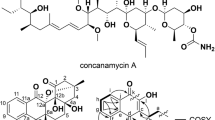Abstract
The Gram-positive, mycelial, differentiating streptomycetes are responsible for the production of many important antibiotics. The availability of gene cloning systems in this microbial group would have many industrial applications1 besides allowing more penetrating study of the genetics of Streptomyces coelicolor A3(2) (which, as the best understood streptomycete genetically, serves as a model for much other Streptomyces genetics)2. Recent successes3,4 (see previous paper4) in introducing Streptomyces DNA into S. coelicolor and Streptomyces lividans on plasmid vectors would be nicely complemented by the availability of Streptomyces bacteriophage vectors (discussed in ref. 5): for example, many phages have wide and easily defined host ranges; heat-inducible prophages might be used to give high copy number of cloned DNA; efficient phage promoters might be used to increase gene expression; there may be differential stabilities for particular DNA sequences cloned in plasmids vis-à-vis phages; selective insertion of DNA, utilizing packaging constraints, may be possible with phages; and in situ hybridization6 of radioactive probes to DNA in plaques is likely to be simple. We describe here the use of the moderately wide host range temperate phage, ΦC317, for this purpose.
This is a preview of subscription content, access via your institution
Access options
Subscribe to this journal
Receive 51 print issues and online access
$199.00 per year
only $3.90 per issue
Buy this article
- Purchase on Springer Link
- Instant access to full article PDF
Prices may be subject to local taxes which are calculated during checkout
Similar content being viewed by others
References
Hopwood, D. A. & Chater, K. F. Phil. Trans. R. Soc. B290, 313–328 (1980).
Hopwood, D.A., Chater, K.F., Dowding, J.E. & Vivian, A. Bact. Rev. 37, 371–405 (1973).
Bibb, M. J., Schottel, J. L. & Cohen, S. N. Nature 284, 526–531 (1980).
Thompson, C. J., Ward, J. M. & Hopwood, D. A. Nature 286, 525–527 (1980).
Chater, K. F. Devl ind. Microbiol. (in the press).
Benton, W. D. & Davis, R. W. Science 196, 180–182 (1977).
Lomovskaya, N.D., Mkrtumian, N.M., Gostimskaya, N.L. & Danilenko, V.N. J. Virol. 9, 258–262 (1972).
Suarez, J. E. & Chater, K. F. J. Bact. 142, 8–14 (1980).
Sutcliffe, J. G. Nucleic Acids Res. 5, 2721–2728 (1978).
Bolivar, F. et al. Gene 2, 95–113 (1977).
Hepburn, A. G. & Hindley, J. J. biochem. biophys. Meth. 1, 299–308 (1979).
Sladkova, I. A., Lomovskaya, N. D. & Chinenova, T. A. Genetika 13, 342–344 (1977).
Chater, K. F. Nucleic Acids Res. 4, 1989–1998 (1977).
Chater, K. F. & Carter, A. T. J. gen. Microbiol. 109, 181–185 (1978).
Kleckner, N., Roth, J. & Botstein, D. J. molec. Biol. 116, 125–159 (1977).
Chater, K. F. & Wilde, L. C. J. Bact. 128, 644–650 (1976).
Lomovskaya, N. D., Chater, K. F. & Mkrtumian, N. M. Microbiol. Rev. (in the press).
Author information
Authors and Affiliations
Rights and permissions
About this article
Cite this article
Suarez, J., Chater, K. DNA cloning in Streptomyces: a bifunctional replicon comprising pBR322 inserted into a Streptomyces phage. Nature 286, 527–529 (1980). https://doi.org/10.1038/286527a0
Received:
Accepted:
Issue Date:
DOI: https://doi.org/10.1038/286527a0
This article is cited by
-
Recent advances in genetic modification systems for Actinobacteria
Applied Microbiology and Biotechnology (2017)
-
Cloning and expression of the SalI restriction-modification genes of Streptomyces albus G
Molecular and General Genetics MGG (1988)
-
Production of ‘hybrid’ antibiotics by genetic engineering
Nature (1985)
-
Molecular cloning of the whole biosynthetic pathway of a Streptomyces antibiotic and its expression in a heterologous host
Nature (1984)
-
Coupled transcription — translation in extracts of Streptomyces lividans
Molecular and General Genetics MGG (1984)
Comments
By submitting a comment you agree to abide by our Terms and Community Guidelines. If you find something abusive or that does not comply with our terms or guidelines please flag it as inappropriate.



